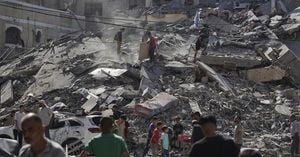The increased military activity and geopolitical tensions surrounding the Arctic region have sparked serious concerns among world leaders and military strategists. Recent reports indicate heightened operations by the North American Aerospace Defense Command (NORAD), particularly following sightings of Russian military aircraft over the Arctic. These aircraft, detected last week, did not breach the identification zones of Alaska and Canada or invade the national airspace of either nation. Nonetheless, NORAD initiated multiple armed patrols on January 28, consisting of CF-18 Hornets and KC-135 tankers from Canada, alongside U.S. Air Force deployments of F-35 Lightning II fighters and E-3 AWACS early warning aircraft.
Shortly after operations began, NORAD deployed F-16 Fighting Falcons from Alaska to Greenland under standard agreements aimed at increasing Arctic presence. This strategic move was reiterated as not being sandwiched between immediate threats, marking another layer of precaution as tensions rise. Notably, President Donald Trump's earlier claims over Greenland feed long-standing anxieties surrounding territorial assertions and military buildups.
Russia’s military expansion is equally formidable, as experts warn of the country bolstering its territorial claims throughout the Arctic. Klaus Dodds, a professor of geopolitics, noted, "Paradoxerweise gibt es in der Arktis keine offenen Territorialstreitigkeiten," underlining the complexity of interactions amid the looming conflict. The Ukraine war has reverberated even through ice, facilitating Russia's aggressive posture. It becomes evident here, as the Economist pointed out, with the Arctic serving as the battleground for three superpowers: Russia, China, and the United States seeking strategic and resource advantages.
Indeed, there is urgency behind these developments. Colin Wall from Reuters remarked, "Im Moment ist das militärische Gleichgewicht in der Arktis stark auf der Seite Russlands." This statement highlights the precarious military balance favoring Russia; NATO's infrastructure, consisting of military installations, does not match the scale of Russia's commitment. According to data from the International Institute for Strategic Studies, the number of Russian military bases within the Arctic Circle outnumbers those of NATO by one-third.
This military buildup is extensive. Over roughly the last six years, Russia has established at least 475 military locations along its northern border, according to the Economist. Among these are 32 continuously manned bases noted by the Canadian think tank Simon’s Foundation—significantly more than their counterparts from NATO countries. While NATO partners may nominally possess more bases, the strategic advantage appears skewed toward Russia due to its substantial Arctic population and potential troop presence.
Despite some analysts’ thoughts on the operational capabilities of Russia's ground forces, which might have diminished following the Ukraine war, there lies significant strength within its naval forces, particularly the strategic submarine fleet. The Center for Strategic & International Studies warns of Moscow's enduring credible counter-strike capability.
Adding complexity to the scenario, the Arctic is increasingly seen as pivotal for global maritime defense. Volker Rachold describes how Russia focuses intensively on its Northern Fleet to deter NATO, contrasting historical military postures. Three air bases are slated to bolster capabilities around Severomorsk, potentially enhancing operational efficiency for any prospective conflict with NATO.
Yet, the NATO response is becoming apparent. Both U.S. and allied forces are ramping up investments directed toward enhancing reconnaissance and surveillance capabilities. Admiral Daryl Caudle’s sentiments echoed concerns over Russia’s escalated activities since the Ukraine conflict. Noting the importance of maintaining U.S. presence, he indicated the potential for aircraft carrier battle groups such as the USS Harry S. Truman to help secure strategic interests.
The shifting dynamics have prompted alarms at various levels. U.S. Coast Guard Commanders have voiced concerns over the impacts of climate change, describing the melting Arctic ice as paving the way for increased shipping and military encounters. Vice Admiral Nathan Moore expressed, "Etwas Schlimmes wird passieren," capturing the urgency with which decision-makers view these changes.
While military activities continue to spiral upwards, the geopolitical stakes remaining intertwined with historical root concerns. Both military experts and government insiders now regard the Arctic as another pressure point looming alongside the challenges defined by the Ukraine conflict and the Baltics, magnifying the potential for confrontation between Russia and NATO. The recalibration of military strategies shows the far-reaching consequences of national security concerns and the Arctic’s rising profile as both resource-rich and strategically important. The international community watches closely as these forces are pitted against each other, contemplating what will come next amid the stark cold of the Arctic expanse.



